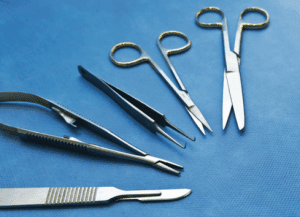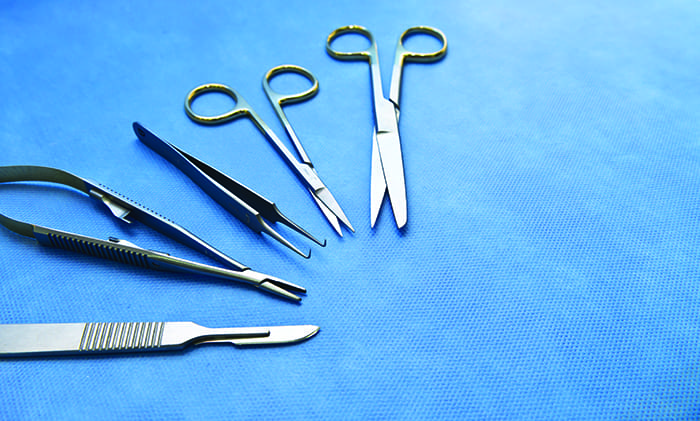Nurses should have reprocessing knowledge, training, and competency.
Takeaways
- In 2018, more than 50% of hospitals surveyed by The Joint Commission were found to be noncompliant with high-level disinfection and sterilization standard IC.02.02.01, EP2.
- Careful and detailed reprocessing of medical devices is necessary to protect patients from harm and minimize the risk of damage to instruments and equipment.
- Nurses should know several core reprocessing concepts, and they should be trained in the complex cleaning, disinfection, and sterilization processes.
IN 2018, more than 50% of hospitals surveyed by The Joint Commission were found to be noncompliant with high-level disinfection and sterilization standard IC.02.02.01, EP2. The problem extends well beyond hospitals. In 2018, 42.5% of accredited ambulatory organizations, 38% of critical access hospitals, and 58% of office-based surgery programs also were found to be noncompliant.
Careful and detailed reprocessing of medical devices is necessary to protect patients from harm and minimize the risk of damage to instruments and equipment. Failure to reprocess in a manner consistent with the intended use of the device, to follow standard procedures, or to follow manufacturer’s instructions for use (IFUs) has led to patient harm and resulted in adverse accreditation decisions. These failures are the main reasons for “immediate threat to health and safety” findings that automatically result in a preliminary denial of accreditation and notification of the Centers for Medicare and Medicaid Services (CMS) and state health departments.
follow standard procedures, or to follow manufacturer’s instructions for use (IFUs) has led to patient harm and resulted in adverse accreditation decisions. These failures are the main reasons for “immediate threat to health and safety” findings that automatically result in a preliminary denial of accreditation and notification of the Centers for Medicare and Medicaid Services (CMS) and state health departments.
High-level disinfection and sterilization issues are so widespread that the Food and Drug Administration (FDA) and the Centers for Disease Control and Prevention (CDC) have emphasized the need for a reliable, high-quality infrastructure to support reprocessing that includes:
- competent leadership oversight and support
- staff knowledge, training, and competency
- rigorous adherence to IFUs
- strict quality control of cleaning, disinfection, and sterilization processes
- detailed routine inspection and maintenance.
Improving nurse competency
After spending the last 30 years of my career in infection prevention, I know how common it is for people to think nurses are competent in everything related to medical care. However, other than those who have worked in operating rooms or procedure areas, most nurses haven’t had the opportunity to obtain knowledge, develop skills, and gain competency in reprocessing medical devices and equipment.
Nurses should know several core reprocessing concepts, and they should be trained in the complex cleaning, disinfection, and sterilization processes if they are responsible for reprocessing or oversight of reprocessing. Leadership is responsible for providing this education and training with the appropriate physical facilities, compatible supplies and equipment, access to IFUs and evidence-based guidelines/national standards, and standardized workflows and procedures.
Leaders, nurses, and everyone performing reprocessing tasks have a role to play in ensuring proper disinfection and patient safety.
What nurse leaders should know
Healthcare organizations should follow a hierarchical approach to disinfection and sterilization, including reviewing and incorporating rules and regulations, CMS conditions for coverage (CfCs) and conditions for participation (CoPs), IFUs, evidence-based guidelines and national standards, and consensus and position statements. (See Keys to leadership success.)
Keys to leadership successLeadership success related to disinfection and sterilization includes:
|
Rules and regulations for disinfection and sterilization include those established by the FDA, state health departments, and the Occupational Safety and Health Administration (OSHA). For example, OSHA requires that all employers protect employees from exposure to pathogens during reprocessing. Employers must perform a hazard assessment to determine the appropriate personal protective equipment for employees to wear during reprocessing, provide the equipment and train- ing on its use and limitations, and enforce its use.
CfCs and CoPs (along with local, state, and federals laws) must be complied with by organizations that use Joint Commission accreditation for deemed status purposes. The State Operations Manual (which includes CfCs, CoPs, the survey, and certification letters that provide clarification of survey requirements) is available via the CMS website. Nurse leaders should pay particular attention to Survey and Certification Letter 14-44, which provides direction on how immediate-use steam sterilization (IUSS) will be surveyed.
IFUs provide critical information necessary for effective and consistent reprocessing and should be available to all staff. Manufacturers are the experts on their own devices. They know the equipment components and how they may be affected by disinfection processes or products. Deviation from IFUs may result in biological, chemical, or functional incompatibility. When conflicts are identified, organizations are expected to resolve them by contacting manufacturers. IFU compliance also should be integral to initial and ongoing staff education, policy and procedure development, and competency assessments.
Evidence-based guidelines are available from many organizations, including the CDC, Association for Advancement of Instrumentation, Association of periOperative Registered Nurses, and the Society of Gastroenterology Nurses and Associates. Some state regulators have incorporated evidence-based guidelines into their regulations and mandate that organizations follow them. Unless prescribed by a Joint Commission standard, such as the requirement to follow standard precautions, organizations may choose the evidence-based guidelines that they will follow.
Consensus and position statements frequently provide additional validation of widely accepted evidence-based guidelines and information about specific settings or types of equipment. A commonly referenced position statement is the joint American Society of Cataract and Refractive Surgery and the American Society of Ophthalmic Registered Nurses recommended practices for cleaning and sterilizing intraocular surgical instruments.
What all nurses should know
Device and equipment reprocessing is performed based on how an item will be used and the resulting risk of infection, and nurses should be aware of the federal regulations that govern labeling and reprocessing. They also should know that not everything can be reprocessed. If an item is labeled for single use, it must be approved for reuse and then prepared, packed, and shipped to an off-site reprocessing facility. A helpful tool is the Spaulding classification (cdc.gov/infectioncontrol/ guidelines/disinfection/rational-approach.html), which categorizes items according to the degree of risk for infection:
- Critical items that come in contact with or enter sterile tissue, a sterile body cavity, or the vascular system (surgical and dental instruments, implants, endocavity probes used in sterile procedures) must be sterilized before first use and after each subsequent use.
- Semicritical items that come in contact with mucous membranes or nonintact skin (laryngoscope blades, esophageal dilators, endocavity probes, ophthalmology equipment that touches but does not penetrate the eye) must be, at minimum, high-level disinfected.
- Noncritical items that come in contact with intact skin (patient beds, blood pressure cuffs, pulse oximeter probes) must be cleaned and/or low-level disinfected in accordance with the manufacturer’s IFU.
Cleaning starts at the point of use and is the first step before disinfection or sterilization. Nurses should follow their organization’s policy for keeping soiled instruments moist until cleaning so that debris doesn’t dry and become difficult to remove. Strategies used by some organizations include covering the item with a towel moistened with sterile water (never saline because it will damage the instrument), covering it with a detergent or enzymatic spray, or placing it in a container that maintains humidity.
Items must be disassembled and cleaned in accordance with manufacturer IFUs. A dirty item should never be disinfected or sterilized; there is no such thing as disinfected or sterile bioburden. Importantly, reprocessing should never be performed in an exam room sink.
All sterilized and high-level disinfected items should be stored in compliance with manufacturer instructions and in a manner that doesn’t compromise packaging. Nurses should never assume an instrument or device is sterile or high-level disinfected. They should always perform a final check to ensure an item is ready for use. (See Final review before use.) Nurses who suspect or identify a problem with a reprocessed item should notify the area manager and report the incident via the organization’s safety reporting process.
OSHA requires that all sharp items be placed in a puncture-resistant container that’s leakproof on sides and bottom and labeled biohazardous before transport, even if it’s being moved only from the exam room to a soiled holding room.
Final review before useBefore an item is used on a patient, nurses should perform a final check to ensure that the item has been high-level disinfected or sterilized as required for the procedure and item.
|
What reprocessing personnel should know
Personnel performing reprocessing tasks should be provided with appropriate education and training. To ensure they’re competent at these complex processes, they should feel comfortable requesting additional training.
Reprocessing personnel should follow all manufacturer IFU steps. If instructions aren’t clear or issues are identified, staff should contact the manufacturer. Instrument release should be a thoughtful and deliberate process, and quality controls and indicators must be used for every item. Physical cycle monitoring (time, temperature, and pressure) and checking external (or internal, if visible through the packaging) chemical indicators are required for every steam and low-temperature sterilization cycle performed. Initialing the sterilizer printout or recording the time, temperature, and pres- sure of each cycle are required as evidence that the physical parameters were monitored.
IUSS should include all cleaning, decontamination, and rinsing steps. Because the cycle parameters required to achieve sterilization are determined by instrument design, load characteristics, and sterilizer capabilities, organizations should follow the validated written instructions provided by the device manufacturers, sterilization equipment manufacturers, and container manufacturers. Organizations that are accredited under CMS CoPs should be aware that IUSS must be reserved for emergency use, when a needed instrument has been contaminated and no sterile replacement is available, or for a patient care item that can’t be packaged, sterilized, and stored before use. If IUSS is performed, all documentation should comply with regulatory, CMS, IFU, and evidence-based guidelines.
Survey preparednessThe Joint Commission on-site survey of infection prevention and control standards examines an organization’s process to help uncover areas for improvement. Surveyors may:
An organization that has invested the resources to ensure that their nurses have the knowledge, training, and competency to fulfill their role related to disinfection and sterilization should do well on the survey. But even more important—nurses will be able to protect patients from adverse events that occur when safe disinfection and sterilization processes haven’t been implemented. |
Keeping patients safe
An organization that has invested the resources to ensure nurses have the knowledge, training, and competency to fulfill their role related to disinfection and sterilization should do well in Joint Commission on-site surveys. (See Survey preparedness.) In addition, nurses should be proactive in identifying issues that might compromise the safety and effectiveness of reprocessing and bring them to leadership’s attention to promote patient safety.
Sylvia Garcia is the director of infection prevention and control at The Joint Commission.
Selected references
Association for the Advancement of Medical Instrumentation, Accreditation Association for Ambulatory Health Care, Association of periOperative Registered Nurses, Association for Professionals in Infection Control and Epidemiology, ASC Quality Collaboration, Association of Surgical Technologists, International Association of Healthcare Central Service Materiel Management. Immediate-use steam sterilization. s3.amazonaws.com/rdcms-aami/files/production/public/FileDownloads/Products/ST79_Immediate_Use_Statement.pdf
Centers for Medicare & Medicaid Services. Change in terminology and update of survey and certification (S&C) memorandum 09-55 regarding immediate use steam sterilization (IUSS) in surgical settings. August 29, 2014. cms.gov/Medicare/Provider-Enrollment-and-Certification/SurveyCertificationGenInfo/Policy-and-Memos-to-States-and-Regions-Items/Survey-and-Cert-Letter-14-44.html?DLPage=1&DLEntries=10&DLFilter=14-44&DLSort=3&DLSortDir=descending
Occupational Safety and Health Administration. Quick reference guide to the bloodborne pathogens standard. osha.gov/SLTC/bloodbornepathogens/bloodborne_quickref.html



















2 Comments.
It is my understanding that sterile processing have technicians and no longer routinely use licensed nurses in a hospital setting. I feel the article would be better if it included departments, settings and kind of staff employed.
Central/ Sterile Processing departments hire sterile processing technicians who have CBSPD or IAHCSSM certifications. Nurses are the ones who send and receive instrumentation to from/to SPD from the operating rooms (and/or picked up by SPD techs).